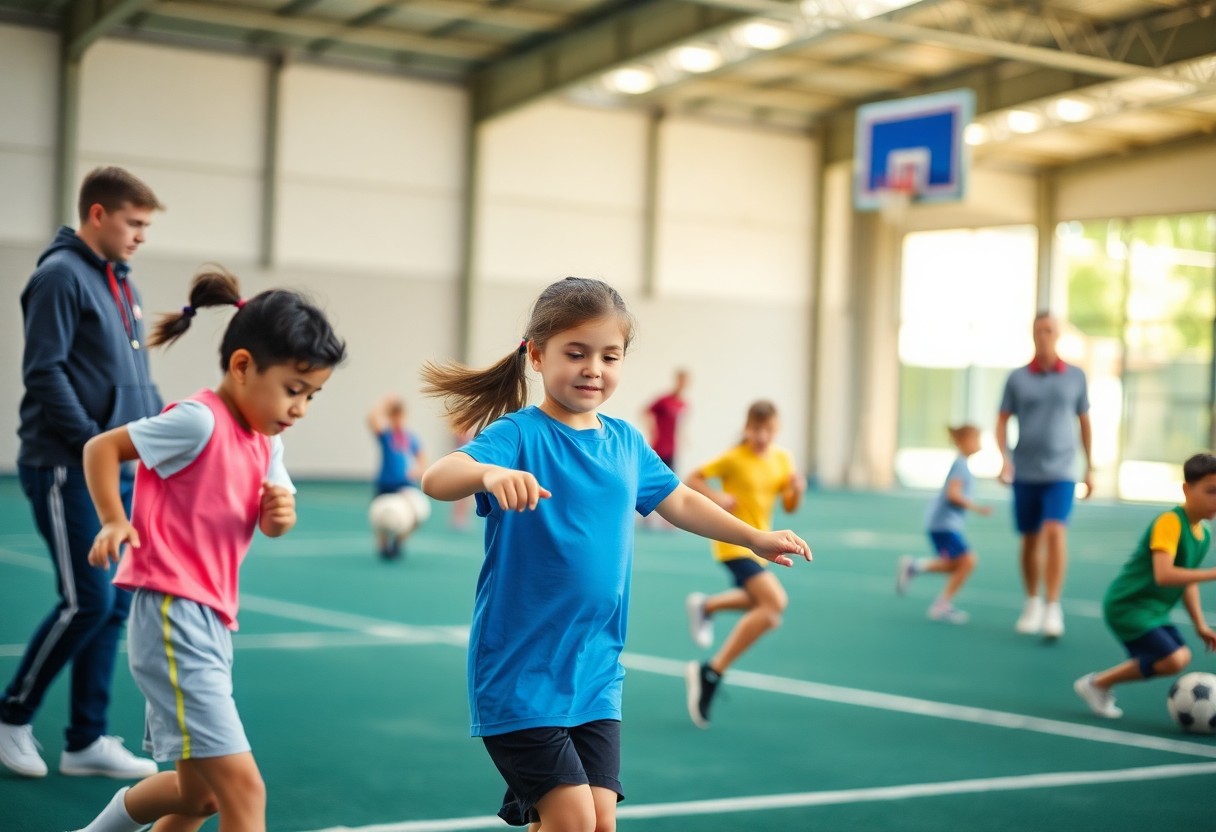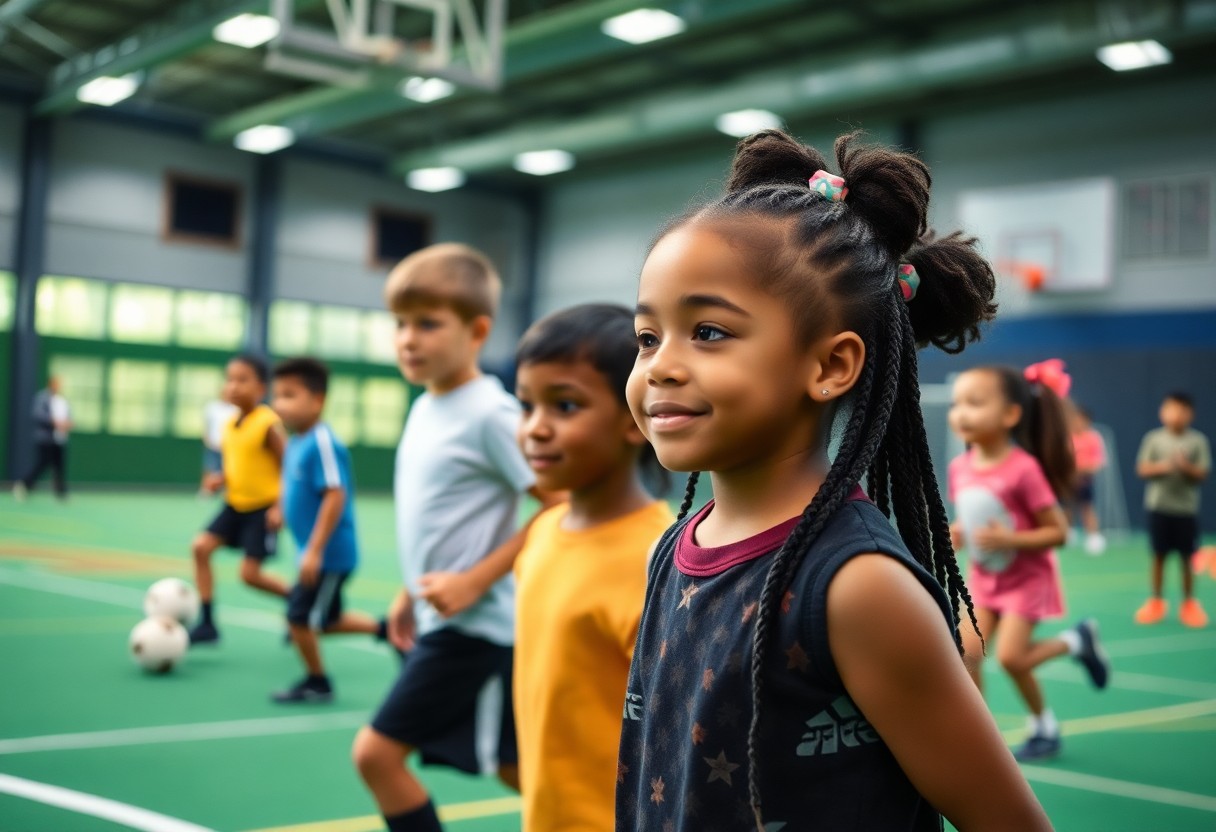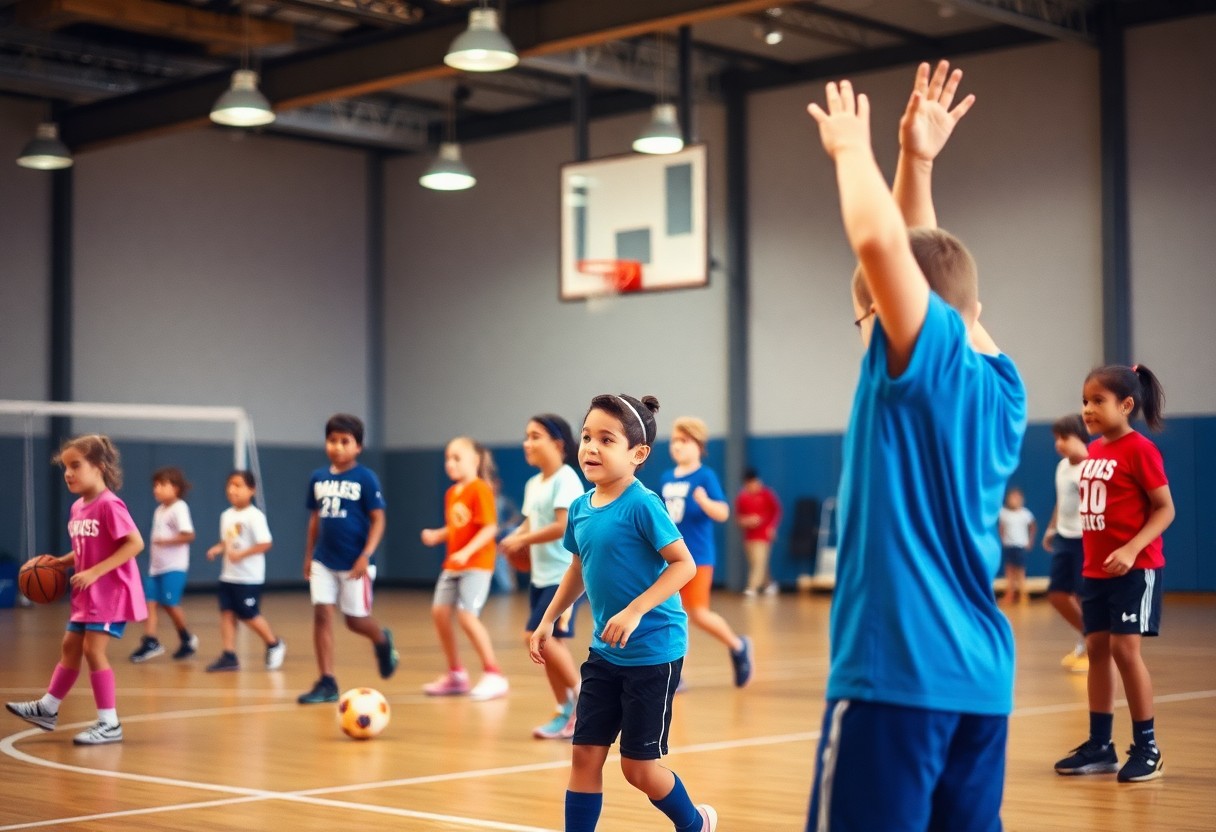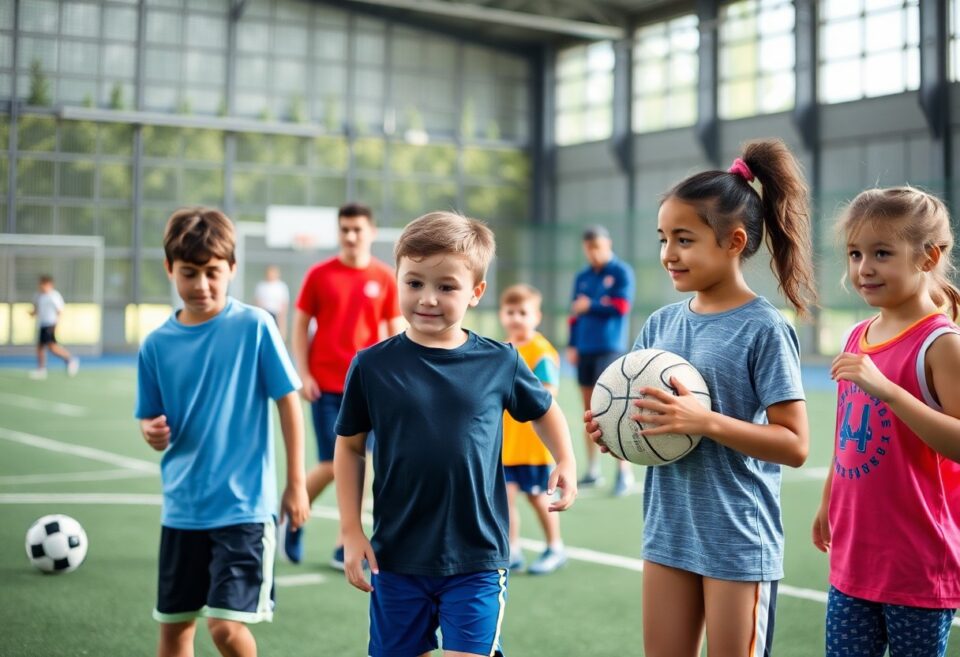There’s a vital window in your child’s development where you can set them on a path to lifelong fitness and success in sports. By focusing on proper technique, balanced training, and injury prevention, you ensure your child builds strength and confidence safely. This guide empowers you to create a program that nurtures skills without risking burnout or overuse injuries, helping your young athlete thrive both physically and mentally from the very start.

Crafting a Dynamic Training Environment
Creating a Supportive Atmosphere for Young Athletes
In your role as a coach or trainer, shaping an environment that fosters encouragement and resilience has a profound impact on a child’s athletic journey. Establishing open lines of communication where young athletes feel safe to express their frustrations or concerns leads to stronger trust and better overall progress. Take, for example, a basketball camp that integrates regular feedback sessions, allowing kids to discuss both achievements and setbacks. This kind of setting offers a scaffold for growth beyond physical skills, nurturing mental toughness and emotional intelligence.
Beyond verbal encouragement, incorporating group activities that promote teamwork can significantly increase camaraderie among your athletes. Designing drills that require cooperation, such as relay races or paired skill challenges, helps children appreciate each other’s strengths while understanding the value of collective effort. In a soccer training program with over 50 participants, coaches noted a 30% improvement in players’ social interaction and conflict resolution skills after implementing paired exercises and team-building workshops.
Recognizing individual progress consistently also keeps young athletes motivated. Offering specific praise for improvements in technique or effort rather than just winning results reinforces positive habits. A study involving youth swimmers highlighted that children who received personalized positive feedback showed a 25% increase in practice attendance and engagement. Tailoring your coaching language to focus on effort and persistence helps shape a healthy, supportive atmosphere where kids feel valued for their hard work as much as their achievements.
Balancing Competition and Fun in Sports Training
Striking the right balance between competitive challenges and enjoyable experiences can shape how children perceive sports throughout their lives. Incorporating mini-tournaments with rotating partners and varied skill levels introduces a competitive element that sharpens focus and strategic thinking. Yet, blending these with playful games, such as obstacle courses or freestyle skill showcases, keeps the mood lively and reduces pressure. This balance has been linked to sustained participation rates in youth leagues, with one national survey revealing that 68% of children whose programs mixed competition and creative play continued sports involvement past age 12.
Avoiding an overly results-driven approach enables you to celebrate milestones that extend beyond scoreboard outcomes. Fostering an environment where trying new techniques or experimenting with different positions is welcomed encourages exploratory learning. One soccer academy emphasized this by allocating 20% of each training session to fun, unstructured play, which led to noticeable increases in skill versatility and overall enjoyment among players. This method allows youngsters to develop a deep connection to sports, building intrinsic motivation rather than relying on external rewards alone.
The role you play in modeling enthusiasm and positive attitudes during competitions also sets the tone. Demonstrating sportsmanship and applauding effort from all participants encourages respect and teamwork. In youth gymnastics programs, coaches who actively engage with athletes by highlighting improvement stories and personal bests witnessed a 40% reduction in dropout rates. This approach nurtures a culture where kids associate sports with personal growth and community, rather than just winning trophies.
Moreover, creating explicit goals that blend competitive skills with fun objectives helps maintain this equilibrium. You might establish monthly challenges focusing on personal bests in timing or accuracy alongside creative skill expression days. Integrating these diverse goals ensures training sessions remain stimulating and balanced, accommodating various motivations and developmental stages of young athletes.

Essential Physical Skills for Young Athletes
Core Strength and Stability as a Foundation
Developing core strength in young athletes goes beyond merely sculpting visible muscles; it establishes a critical support system for every movement they perform. Strong core muscles serve as the central link between upper and lower body movements, facilitating balance, control, and power transmission. For example, a soccer player with enhanced core stability will maintain better posture during rapid twists or directional changes, reducing the risk of injury and improving effectiveness on the field. You can integrate exercises like planks, bird dogs, and supervised medicine ball throws into your training sessions to cultivate this foundational strength without overwhelming young bodies.
Children’s developing bodies require appropriate loads and progressive challenges. The adaptations your athlete experiences from core strengthening exercises often lead to improved proprioception—the body’s ability to sense its position in space—which is vital for executing complex sports maneuvers. By focusing on functional movements that mimic sport-specific actions, you prompt coordinated muscle activation patterns that translate directly into performance gains. Activities such as crawling drills, balance board exercises, or controlled rotational movements can enhance core stability while maintaining engagement and fun during practice.
Integrating core training effectively means balancing intensity and recovery, especially for growing athletes. Overemphasis on core exercises without adequate rest could lead to fatigue or overuse injuries. Your training plans should incorporate variety, targeting not only abdominal muscles but also deep spinal stabilizers and hip musculature. By systematically developing this stability matrix, you equip your young athlete with the ability to resist unwanted twisting or bending forces, equipping them with resilience against common strains or sprains seen in early sports participation.
Agility and Coordination: The Building Blocks of Performance
Agility transforms a young athlete’s ability to react and adapt to dynamic game situations, allowing rapid changes in direction and speed with precision. Activities like ladder drills, cone weaves, and short sprints sharpen neuromuscular responsiveness and foot placement accuracy, providing the groundwork vital across virtually all sports. Intriguingly, research shows that early development of these skills can enhance neural pathways, leading to more adept motor control as your child progresses in their athletic journey. Introducing varied and unpredictable stimuli during drills challenges both mind and body, promoting quicker decision-making in competitive environments.
Coordination ensures that movements are not only fast but also efficient and controlled. Coordinated athletes minimize wasted energy and reduce the likelihood of missteps that lead to injury. For example, a young basketball player practicing hand-eye coordination through ball-handling drills will find better control during passes and shots under pressure. Exercises such as juggling, rhythmic clapping patterns, or reaction ball activities engage multiple sensory inputs and foster synchronization between limbs. Your role involves creating playful yet purposeful challenges that balance skill acquisition with confidence building.
The synergy between agility and coordination directly influences overall athletic performance; when these skills develop harmoniously, your young athlete can exploit their physical potential more fully. Implementing a progression from simple to complex tasks—like starting with straight-line agility drills then moving to multi-directional movement patterns—encourages adaptability and control. Tracking improvements using measurable parameters such as shuttle run times or error rates during coordination tasks provides valuable feedback, helping you tailor training for optimal growth while keeping motivation high.
Delving deeper, agility and coordination encompass neuromuscular efficiency where rapid communication between the brain and muscles dictates success. You’ll notice that varied training approaches—combining balance, speed, and reaction components—stimulate this connection robustly. Skill retention improves as drills become game-like, transferring seamlessly into real competition scenarios. By emphasizing these competencies early on, you lay the groundwork for advanced technical skills and tactical understanding that will shine as your athlete matures.

Mental Resilience: The Unseen Game Changer
As your child progresses in their sports journey, mental resilience often governs how they face challenges and setbacks on the field. This resilience isn’t just about bouncing back from a bad game but also about maintaining focus and composure under pressure. Studies have shown that athletes who develop strong mental endurance from a young age can improve their performance by up to 30%, especially in high-stress situations. You need to understand that mental toughness is cultivated through consistent encouragement, tactical mental exercises, and real-world experiences that test and strengthen psychological stamina.
Incorporating mental resilience training can positively impact not only your child’s sports skills but also their academic and social life. For example, a young soccer player who has solid coping mechanisms for dealing with competition anxiety can navigate school exams or peer interactions more effectively. You want to foster environments where your child can safely experience failure and learn how to recover, which builds confidence and a healthy attitude towards challenges. Mental resilience will help them sustain motivation even when the path is difficult, an invaluable trait for long-term success both on and off the field.
Your role involves recognizing moments when your child’s mental resilience is tested, such as during losses or moments of physical strain, and using those moments as teaching opportunities. Techniques like visualization, mindfulness, and positive self-talk can be introduced during training sessions to equip your child with tools that reduce stress and improve concentration. Over time, these strategies become second nature and enhance overall performance, ensuring your child is not only physically prepared but mentally ready to face the demands of competitive sports.
Building Confidence Through Positive Reinforcement
Positive reinforcement is a powerful tool that shapes your child’s perception of their abilities and efforts. Offering specific praise for accomplishments rather than vague compliments helps them focus on the actions that lead to success. For instance, instead of saying “Good job,” you might say, “You showed excellent control during that dribble!” This precision builds a clear connection between effort and outcome, cementing a growth mindset. Feedback delivered promptly after a performance also reinforces learning and emotional connection, making children feel valued and motivated to keep improving.
Consistency in positive reinforcement creates a solid psychological foundation where your child views challenges as opportunities rather than threats. Incorporating small rewards aligned with effort, such as extra playtime or recognition during team meetings, also sustains engagement. Research has revealed that kids who receive balanced and specific encouragement demonstrate higher levels of perseverance and reduced fear of failure. Establishing this approach helps your child develop self-assurance in their skills, making it easier for them to tackle new and complex challenges without hesitation.
Avoiding overly critical remarks and reframing mistakes as learning steps can prevent discouragement and build your child’s resilience. You might notice that when young athletes receive coach and parent support that highlights progress instead of just results, they maintain enthusiasm and show greater adaptability. Your awareness of this dynamic lets you tailor encouragement strategies to your child’s individual needs, reinforcing their belief that effort and improvement are what truly matter. Empowered by positive reinforcement, your young athlete will gain a confident mindset that propels performance and personal growth in sports and beyond.
Coping Strategies for Young Athletes in High-Pressure Situations
High-pressure moments can seriously impact a young athlete’s performance, but developing effective coping mechanisms can turn stress into an advantage rather than a hindrance. Breathing techniques like diaphragmatic breathing help regulate physiological responses to anxiety, lowering heart rate and enhancing focus. Engaging in pre-competition routines or visualization of successful plays primes the brain for optimal performance, reducing uncertainty and boosting confidence. For example, a basketball player preparing for free throws with a consistent ritual has a higher likelihood of maintaining composure and accuracy under pressure.
Teaching your child how to break down overwhelming tasks into manageable steps can also decrease performance anxiety. Cognitive-behavioral approaches encourage replacing negative self-talk with affirmations that emphasize their training and strengths. Monitoring emotional states and identifying early signs of stress lets your athlete deploy coping strategies before pressure escalates. Peer and coach support during these moments further buffers anxiety, underscoring the importance of a supportive environment where your child feels safe to express concerns and seek guidance.
Establishing a mindset that frames pressure as a challenge to conquer rather than a threat takes practice but pays dividends. Case studies highlight athletes who have used reframing techniques to elevate their game during clutch moments. You can help your young athlete internalize this perspective by sharing stories of professionals who faced adversity yet thrived through resilience and mental strategy. This preparation builds not only sporting competence but emotional intelligence, allowing your child to navigate stress with poise in both athletics and everyday life.
Expanding on these coping strategies, combining mental rehearsals with physical warm-ups strengthens your child’s readiness before intense games or competitions. Implementing consistent mental skills training alongside physical drills creates a synergy that enhances overall performance. Additionally, teaching mindfulness practices equips young athletes with the ability to center themselves in the present moment, reducing distractions and worry. This holistic approach ensures your child is equipped to manage pressure effectively, thereby maximizing their potential in any sports context.
Nutrition’s Role in Athletic Development
Fueling Young Bodies for Optimal Performance
Young athletes require a delicate balance of macronutrients to sustain energy levels during demanding training and competition days. Carbohydrates serve as the primary energy source, and incorporating complex carbs like whole grains, vegetables, and fruits ensures a steady supply rather than quick sugar spikes. Timing also matters; consuming a carbohydrate-rich snack or meal about 1-2 hours before activity helps maintain glycogen stores and delays fatigue, enhancing endurance for longer practices or games.
Protein intake supports muscle repair and growth, which is especially significant as children develop strength and skill. Lean proteins such as chicken, fish, beans, and dairy products provide imperative amino acids that facilitate tissue recovery after intense workouts. Spatially distributing protein intake throughout the day rather than consuming a large amount at once improves synthesis and keeps amino acid levels consistent for muscle maintenance.
Hydration remains a pivotal aspect often overlooked by younger athletes. Dehydration as little as 2% of body mass can impair coordination, concentration, and overall performance. Regular water intake, especially before, during, and after activity, prevents declines in cognitive function and physical output. Electrolyte replacement is occasionally necessary for extended bouts of sweating, but water alone meets most hydration needs for shorter sessions.
The Myths and Facts of Sports Supplements for Kids
Nutrition companies often market sports supplements as quick fixes for improving kids’ athletic performance, yet many claims lack scientific support or consider safety risks. While protein powders, creatine, and energy drinks might benefit adult athletes under supervision, children should avoid these unless prescribed by a health professional. The immature metabolic systems of growing bodies may process supplements differently, and excessive or inappropriate use can cause side effects ranging from gastrointestinal issues to altered hormone levels.
Multivitamins and mineral supplements can fill dietary gaps if your child’s food intake is insufficient or selective, but they do not replace a balanced diet. Studies show that a nutrient-rich diet caters naturally to almost all imperative vitamin and mineral needs, reducing the necessity for supplementation. Over-supplementing, especially with fat-soluble vitamins like A and D, can lead to toxicity and affect normal growth trajectories.
Parents and coaches frequently worry about performance-enhancing supplements, but evidence consistently points toward solid nutrition and training as the foundational pillars of athletic development. You should scrutinize ingredient lists carefully and seek guidance from qualified healthcare providers before introducing supplements. Relying on whole foods and proper hydration remains the safest and most effective approach for young athletes to excel while protecting their health.
Understanding the boundary between marketing hype and scientific evidence surrounding sports supplements helps you protect your child’s wellness and foster their athletic potential sustainably.
Parental Involvement: Allies in Athlete Success
Facilitating a young athlete’s development often hinges on the quality of parental involvement. Your role extends far beyond transportation or attending games; it shapes the entire sporting experience for your child. Studies have shown that positive parental support correlates with higher motivation and better performance in youth sports, emphasizing that how you engage can either enhance or undermine your child’s athletic journey. Active listening during practice recap conversations, asking thought-provoking questions, and validating your child’s feelings contribute to an environment where they feel respected and empowered to communicate openly about their experiences on the field.
Engagement with coaches and other team officials also provides a platform for reinforcing your child’s growth. By maintaining open channels of communication with those guiding your child’s training, you gain insights into specific skills and areas needing attention. This collaborative approach enables you to support targeted practice routines or mental conditioning outside of training sessions. Research from the Journal of Sports Sciences indicates that athletes whose parents consistently collaborate with coaches demonstrate a 20% increase in skill retention and confidence levels compared to those with less involved parents.
While enthusiasm for your child’s achievements can be infectious, it’s equally important to foster a balanced atmosphere that values effort over outcome. Encouraging reflection on personal progress rather than solely on wins or losses helps nurture intrinsic motivation. You can cultivate resilience in your young athlete by celebrating improvements, no matter how incremental, and modeling how setbacks provide learning opportunities. Your consistent encouragement and positive framing around challenges can profoundly influence their long-term commitment to sport and personal development.
Effective Communication and Support Strategies
Developing effective communication with your child requires understanding their unique way of processing feedback and encouragement. Tailoring your approach—whether through verbal affirmations, constructive critiques, or nonverbal cues—can directly affect how they internalize your support. For example, children who respond well to specific, actionable feedback benefit when you highlight detailed observations, such as “Your footwork improved significantly during that drill,” rather than generic praise. This specificity reinforces skill acquisition and boosts self-awareness.
Adopting a coaching mindset at home, without overstepping into the coach’s domain, nurtures autonomy and resilience in young athletes. Instead of directing every training detail, ask open-ended questions that prompt critical thinking, like “How did you decide on that move?” or “What would you try differently next time?” This approach encourages problem-solving and ownership over their development, building mental toughness and adaptability in competitive scenarios.
Support strategies that bolster confidence also involve creating routines for preparation and recovery that your child can rely on. Helping them implement daily habits—such as hydration, stretching, or visualization techniques—reinforce the discipline required for consistent improvement. The Harvard Medical School’s findings highlight that athletes who adopt these routines experience fewer injuries and enhanced performance, underscoring how your active involvement in these small daily acts makes a significant difference.
Navigating the Fine Line Between Encouragement and Pressure
Providing encouragement while avoiding the imposition of undue pressure is a delicate balance that demands self-awareness and sensitivity to your child’s signals. Overemphasizing results or expressing disappointment can inadvertently elevate stress and anxiety, which has been linked to burnout and dropout in youth sports programs. You can observe signs such as changes in mood, reluctance to attend practice, or expressions of fear around competition that signal when pressure is becoming counterproductive. Adjusting your communication to emphasize process and enjoyment rather than outcomes preserves your child’s intrinsic motivation.
Celebrating effort and character traits such as perseverance and teamwork reinforces values that extend beyond the scoreboard, helping your child develop a well-rounded identity within sports. By focusing on these broader qualities, you shift the narrative away from performance-based evaluation to personal growth. This mindset not only sustains enthusiasm during challenging periods—like recovery from injury or performance slumps—but also prepares your young athlete for healthy relationships and coping strategies for future endeavors.
It can help to recalibrate your own expectations by engaging in reflective practices, such as journaling or discussions with other parents and coaches about balancing ambitions with emotional well-being. Research published in the Journal of Applied Sport Psychology demonstrates that parents who manage their expectations realistically and communicate openly about the pressures of competition contribute to their children’s greater psychological resilience. This modeling teaches your child valuable lessons on self-compassion and managing external demands constructively.
Understanding this balance isn’t always straightforward, and might require periodic reassessment as your child matures and their motivations evolve. Maintaining a dialogue that prioritizes their voice in the conversation helps you stay attuned to when encouragement might unintentionally become pressure. Building this awareness is an ongoing process, one that reinforces your partnership in nurturing a sustainable and fulfilling sports experience.
Final Words
Following this comprehensive overview of kids’ sports training, you can appreciate the many layers involved in building a robust foundation for young athletes. Your role as a guide and supporter is vital in encouraging not only physical development but also in fostering mental resilience and enthusiasm for the sport. By focusing on age-appropriate exercises and nurturing a positive environment, you help your child develop skills that extend beyond the playing field, shaping habits and attitudes that contribute to overall well-being.
It is important to tailor training approaches to meet your child’s unique needs and interests. As you engage in their sports journey, you are facilitating the growth of coordination, balance, and teamwork abilities that underpin future success. Moreover, by keeping their experience enjoyable and aligned with their pace, you maintain their motivation and instill a lifelong appreciation for physical activity, which can lead to healthier lifestyle choices as they grow older.
As you continue to support your child’s sports training, you establish a solid framework that prioritizes safety, skill building, and personal growth. Your commitment to understanding the principles of effective training allows you to make informed decisions and seek expert guidance when necessary. Ultimately, the foundation you help create opens doors to countless opportunities, empowering your child to achieve their potential both on and off the field.
FAQ
Q: At what age should kids begin sports training?
A: Children can start engaging in basic physical activities and playful exercises as early as toddler age. Formal sports training typically begins between ages 5 to 7, depending on the sport and the child’s interest and readiness. Early engagement focuses on general motor skills development rather than sport-specific training.
Q: How can sports training benefit children beyond physical health?
A: Participating in sports enhances social skills such as teamwork, communication, and cooperation. It also promotes discipline, goal-setting, and self-esteem. Additionally, kids learn how to handle success and setbacks in a supportive environment.
Q: What elements should be included in a kids’ sports training program?
A: A well-rounded training program should include fundamental movement skills like running, jumping, and throwing, along with sport-specific techniques introduced gradually. Flexibility, balance, and coordination exercises help build overall athleticism. Emphasizing fun and positive reinforcement is equally important for motivation.
Q: How often should children participate in sports training sessions each week?
A: For young children, 2-3 sessions per week, each lasting 45 minutes to an hour, is appropriate to allow skill development while preventing overtraining. Sessions can increase in frequency and duration as the child grows older and gains experience.
Q: What role does nutrition play in kids’ sports training?
A: Proper nutrition supports energy levels, growth, and recovery. Offering balanced meals with adequate carbohydrates, proteins, healthy fats, vitamins, and minerals helps optimize performance and overall health. Hydration is also crucial before, during, and after activities.
Q: How can parents support their children’s sports training journey?
A: Parents can encourage regular participation by providing positive feedback, attending practices and games, and ensuring their child has the right equipment and rest. Fostering a fun, pressure-free environment helps maintain enthusiasm and a love for physical activity.
Q: What signs indicate that a child may be experiencing burnout from sports training?
A: Signs may include persistent fatigue, loss of interest in the sport, irritability, poor performance, and physical complaints like frequent aches or injuries. If such symptoms appear, it is important to reduce training intensity or take breaks to allow recovery.
